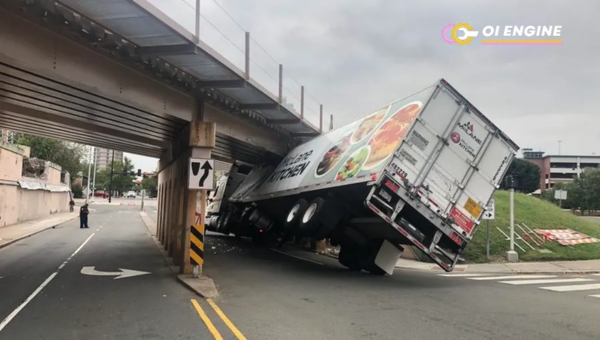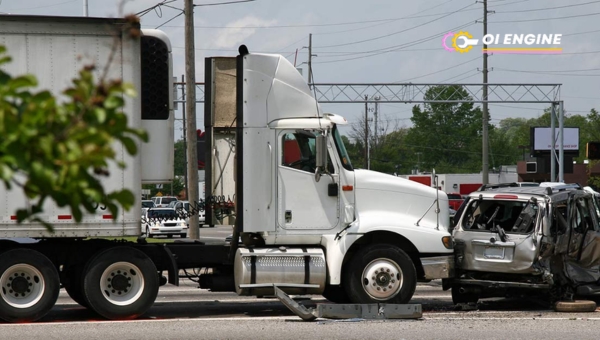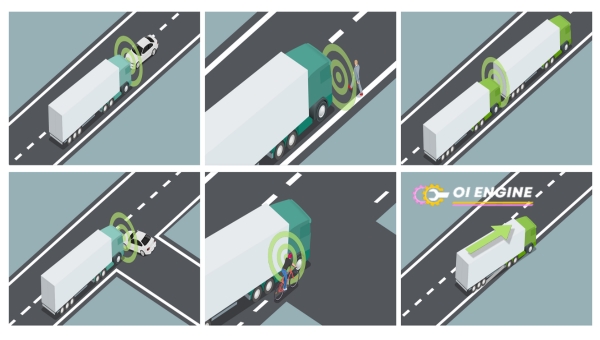Having a bird’s eye view of the 2025 truck accident statistics, it becomes undeniable how crucial understanding these figures truly is. The report provides an insightful lens through which we can better comprehend the severity and frequency of such incidences.
As we delve into the ‘Truck Accident Statistics: 2025 edition, we’ll reveal striking trends and disparities, common causes of these accidents, as well as effective prevention measures.
The volume of truck accident incidents in 2025 experienced a significant rise compared to previous records; not only does this highlight necessary actionable steps towards enhanced driver safety but also indicative narratives behind such figures.
From analyzing state-specific data to assessing the impact on various demographics – all will be revealed in this comprehensive assessment.
Key Truck Accident Statistics
The year 2025 bears witness to critical data underlining the severity of truck-related accidents.

With an emphasis on the increased tendency of such tragic incidents, there is a rising need for public attention and safety measures. Let’s shed light on the major areas marking this serious issue.
Rural Areas Most Prone to Fatal Truck Accidents
The tranquillity of our rural regions sadly stands disrupted with alarming rates of fatal truck incidents – accounting for a whopping 55% of overall statistics. A combination of factors might be contributing to this growing concern.
The tranquil nights in these locales are often devoid of proper lighting systems which gives way to dark country roads – turning them into accident-prone zones.
Adding to the woes of poor visibility is the high likelihood of driver burnout, stemming from long-distance hauls that heighten fatigue levels among operators.
Also, there’s a familiar notion among truckers that less populated terrains invite lesser traffic regulations, providing an opportunity for unnecessary speeding as they’re free from congestion typical in urban landscapes – a primary cause triggering accidents in these areas.
Besides, frequent curves and turns encountered on rural roadways make them more complex to navigate through if compared with city streets, further complicating matters.
Less Than 1% Truck Accidents Involved Hazardous Cargo
Paying heed to the truck accident statistics 2025 edition, it’s somewhat relieving to note how trucks ferrying hazardous items comprise less than 1% of overall crash scenarios.
These particular movers transport dangerous commodities and are recognized as “hazmat trucks”. The stringent safety regulations governing these giants might be the reason behind their minimal presence in collision counts.
This scarce inclination indicates convincing compliance among operatives keenly adhering to rules designed for their specific use case—resulting in fewer hazardous cargo-involved accidents as compared to other large-vehicle crashes recorded over time.
Semi-Trailer Trucks Lead In Fatal Accidents
The unfortunate reservation of top spots in fatal truck incidents is occupied by semi-trailer trucks. These specific designs seeing a front-axle deficit present widespread challenges, making them more prone to serious accidents. They are involved in approximately 53% of total fatal accidents involving larger trucks.
These heavyweight movers with their distinct structure sit at the severe end of crash data, reiterating the urgent requirement for more robust safety protocols and better training programs for operators assigned to handle these specific heavy-duty vehicles.
26% Increase in Large Truck Accidents From 2020 To 2021
The annual comparison between the years 2020 and 2021 reveals a startling progression in large truck accidents – showing an extensive rise of around 26%. In numbers, about four hundred and fifteen thousand large truck crashes were recorded in 2020; which shockingly jumped to over five hundred and twenty-three thousand come next year.
Reduced commuting during pandemic-related lockdowns can be inferred as the reason behind fewer accident counts noted for the year mark 2020.
The gradual lifting of movement restrictions invited back higher volumes of motorists, including big rigs back on roads – explaining the breakneck increase charted during the transition from the year 2020 to its successor.
Over 500,000 Large Truck Accidents in 2021
It’s quite distressing to acknowledge over half a million significant vehicle mishaps occurred within calendar duration through the following year – marking a new high with figures breaching previous records counting above five hundred twenty-three thousand instances.
This staggering number puts into focus the pervasive challenge posed by bulky commercial vehicles navigating our highways – emphasizing their impact on overall road safety statistics across different regions.
To conclude these key notes related to ‘Truck Accident Statistics:2025 Edition, it’s crucial to advocate better safety guidelines not only for heavy-duty vehicle operators but also for encouraging regular road-dwellers coming in frequent contact with these juggernauts on daily routes. This is instrumental in making our streets safer – helping mitigate this pressing issue.
Common Causes of Truck Accidents
Truck accidents are far too common on our highways and roads. Understanding the causes behind these often tragic incidents is crucial to prevent future accidents and enhance safety measures.
Factors leading to truck accidents range from driver fatigue to distractive driving behaviors, each equally dangerous.
Main Reasons behind Accidents
- Driver Fatigue: Driver fatigue can greatly affect a truck driver’s ability to maintain control of their vehicle, making it a leading cause of truck accidents. Due to long working hours, many drivers get insufficient sleep which reduces their alertness level on the road.
- Driving Under Influence: It’s alarming that 6.7% of large truck accidents involved drunk driving or driver intoxication in past years despite stricter Blood Alcohol Content limits for commercial drivers.
- Poor Weather Conditions: Bad weather plays a significant role in causing truck accidents with 13% of large trucks crashing due to poor visibility, snow, ice, or slick roads.
- Speeding: It is shocking that even with lower speed limits for trucks, speeding leads to 7.3% of fatal truck crashes as they’re harder to stop due to greater weight than typical vehicles.
- Daytime Driving: Most think nighttime is dangerous for driving but surprisingly almost four-fifths (79.6%) of large truck wrecks occur during the day caused by higher traffic congestion and increased fatigue amidst daylight hours’ work.
- Driver Impairment and Inattention: Whether it’s using cell phones while driving or eating at the wheel, such distractions contribute to 5.2% of deadly collisions amongst large trucks because they divert focus off the road ahead.
Despite efforts made in promoting safer practices within the commercial transportation sector these factors still persistently contribute towards a major portion of serious road crashes especially involving larger vehicles like trucks which leave lasting impacts both on individuals’ lives as well infrastructure overall hence emphasizing the urgency required to tackling them appropriately for achieving safer roads effectively.
Latest 2025 Commercial Truck Accident Statistics Revealed
As someone who keeps a close eye on the road, I find myself frequently ruminating about truck accident statistics. The figures from the latest 2025 reports have been quite revealing, I must say.

Commercial Trucks: 4% of Vehicles, 12% of Fatalities (NHTSA)
The National Highway Traffic Safety Administration lets us know that commercial trucks make up just a tiny segment (only 4%, to be exact) of vehicles actively navigating our streets and highways.
However, it’s frightening to learn that they’re involved in a considerable chunk of fatal accidents—12%, if we’re to believe these sobering stats.
One Semi-Truck Collision Every 15 Minutes (DOT)
Now here’s a figure sure to raise your eyebrows: data from the Department Of Transportation suggests that every single quarter-hour in the United States witnesses a semi-truck collision.
Just imagine – every time you sit down for your favorite TV show without commercials, there’s been another collision somewhere across America involving one of these hefty vehicles.
Driver Fatigue Causes 30% of Truck Accidents (NHTSA)
Fatigue is something we can all relate to after a weary day’s work. But when truck drivers push painstakingly past their limits? That’s where problems start gearing up in earnest.
In fact, according to the NHTSA’s findings, driver fatigue is singlehandedly responsible for nearly one-third — or zooming in closer for better clarity – around 30 out of every hundred commercial truck accidents occur due to this weariness taking its toll on drivers’ focus and reactions.
74% of Fatal Crashes Involve Tractor-Trailers (IIHS)
One statistic that always stands out to me is this: according to the Insurance Institute for Highway Safety (IIHS), an enormous 74% of fatal crashes involve tractor-trailers. This fact underlines just how deadly these vehicles can be in situations where accidents occur.
2% Decrease in Large Truck Fatal Crashes in 2019 (FMCSA)
On a more positive note, I felt a glimmer of hope when I learned that there was a decrease in fatal truck crashes back in 2019.
The Federal Motor Carrier Safety Administration reported that there was a slight but still impactful reduction – specifically, large truck accidents led to fatalities less frequently by 2%.
Though it’s not an overwhelming dip, any improvement gives me hope for future progress if we continue earnest prevention efforts.
Rollovers in one-third of Fatal Truck Accidents (FMCSA)
But other statistics pulled me back to the harsh real-world scenarios. Take this from FMCSA’s data: A shocking one-third of all fatal truck accidents involve rollovers!
This fact emphasizes our collective need to address safe driving protocols and revise cargo load standards if needed because even some fractions reduced can save lives.
Tractor-Trailers in 67% of Fatal Truck Accidents
According to data from the Federal Motor Carrier Safety Administration (FMCSA), tractor-trailers were involved in a significant 67% of fatal commercial truck accidents in 2018. Tractor-trailers are huge vehicles that carry a lot of weight.
This means when they get involved in an accident, the outcomes can be devastating. In particular, these kinds of big trucks have been the main cause of major road fatalities.
One in Three Truck Drivers Involved in Serious Accidents
The Center for Disease Control (CDC), reported some equally unsettling facts for the year 2018 – one out of every three truck drivers admitted having been part of a severe truck accident during their career lifetime.
That translates to about 33%; an astonishingly high figure! It offers quite an insight into just how frequent and likely these grave incidents are for truck drivers.
21% of Truck Occupant Deaths Were Truck Drivers
The Insurance Institute for Highway Safety (IIHS) reports added yet another alarming layer to this picture by stating that out of every five deaths occurring inside trucks due to accidents, approximately one was that of the driver in 2019. In simpler terms, about 21% of drivers who occupied large trucks lost their lives while driving them.
Large Trucks in 11% of Motor Vehicle Crash Deaths (FMCSA)
The Federal Motor Carrier Safety Administration’s recent studies reveal that a disturbing 11% of all motor vehicle crash deaths involve large trucks.
This indicates the massive risk these vehicles impose on roads. With their size and weight, trucks potentially cause extensive damage during accidents, resulting in high fatality rates.
Brake Issues in 30% of Truck Accidents (FMCSA)
Brake issues reportedly cause approximately one-third of all truck accidents. This figure uncovers the importance of regular vehicle maintenance to ensure road safety. Inadequate brake systems can lead to significant complications, causing drivers to lose control and possibly incite collisions.
Therefore, preventive measures include regular inspections and servicing to detect and rectify braking issues early on.
Safety Belts Reduced Fatalities by 40% (FMCSA)
The Federal Motor Carrier Safety Administration’s data uncovers an optimistic trend: the use of safety belts has contributed to a 40% reduction in fatalities related to truck accidents.
This statistic is a clear testament that following basic safety protocols can save lives. Despite the advancement in vehicle safety technologies, nothing replaces the effectiveness of buckling up.
Therefore, all vehicle occupants, including truck drivers, are advised to consistently use safety belts as they significantly reduce the risk and severity of injuries during accidents.
11,150 Heavy Truck Accidents in NY (NY State DMV)
According to the New York State Department of Motor Vehicles (DMV), 2019 saw a shocking number of heavy truck accidents in New York alone.
An estimated 11,150 incidents were recorded which led to more than 4,800 injuries. This sheer number underlines the critical risk associated with heavy trucks on the road and emphasizes the need for better safety measures.
Speed Involved in 17% of Fatal Truck Crashes (IIHS)
Speed is another significant matter that contributes to fatal truck crashes. The Insurance Institute for Highway Safety (IIHS) report indicates that speed played a part in about 17% of truck crashes that caused fatalities involving truck occupants in 2018.
Regulating speed limits for large vehicles like trucks may be instrumental in reducing such accidents in the future.
1 in 3 Truck Drivers Experienced a Crash (ATA)
The American Trucking Association (ATA) reports indicate that more than one out of three truck drivers experienced an accident at some point during their careers. It shows a direct impact on those operating these heavy vehicles, demanding immediate attention towards driver security and continuous training programs.
Northeast Leads in Fatal Truck Accidents (FMCSA)
The northeast region of the United States trails no other region when it comes to fatal truck accidents.
According to the Federal Motor Carrier Safety Administration, 14% of all fatal commercial truck accidents in 2019 took place in this region.
In simple words, nearly one out of every seven fatal commercial truck accidents happened here. This shocking fact underlines a severe issue requiring immediate measures for improving road safety.
31% Increase in Truck Crash Fatalities Since 2009 (IIHS)
In a span of just over a decade from 2009 to 2019, there has been a steep rise in fatalities due to truck crashes—an increase of almost one-third, as revealed by the Insurance Institute for Highway Safety (IIHS).
This is indeed troubling as it signifies that though we are moving forward in terms of technology and safety measures, we seem to be lagging in practical execution and implementation on roads.
96% of Vehicle Occupants Killed in Truck Crashes Were in Passenger Vehicles (IIHS)
The fact presented by IIHS elucidates one chilling aspect: if you happen to get involved in a collision with a large truck while traveling by passenger vehicle, chances are slim for survival.
A staggering number – 96% or almost all vehicle occupants killed were from passenger vehicles. Not only does this assert the lethality risk involved for passenger vehicles’ occupants but also highlights the urgency for adopting strict traffic rules and promoting public awareness related to safe driving habits.
Tire Issues: Third Most Common Truck Accident Cause (FMCSA)
Faulty tires claim yet another infamous spot when it comes down to common causes linked with truck accidents.
As per Federal Motor Carrier Safety Administration information, tire issues persist as the third common cause leading up to significant mishaps involving trucks on our streets and highways.
This emphasizes why frequent checks on tires’ condition should never be overlooked; indeed, they are not just another item on maintenance schedules but rather a crucial component promising safe journeys.
Truck Accidents Statistics by State
Truck accident statistics vary greatly depending on geographical location. Different states have unique factors affecting these numbers – their road conditions, traffic laws, and driving culture all play essential roles.
State Specific Data
Every state has its own unique story when it comes to truck accidents. Here’s how some of the states fared:
- Texas: This southern state holds the unfortunate title of having the highest amount of fatal large truck accidents in 2020. It is a significant distribution hub and possesses many highways which could be contributing to this high rate.
- Wyoming: Surprisingly, Wyoming had the largest number of fatal large truck accidents per capita in 2020 even though it has a relatively small population size. The presence of treacherous mountain roads might be a major contributor here.
- Washington DC and Vermont: On a brighter note, Washington D.C (District of Columbia) and Vermont had the least amount of fatal large truck accidents in 2020 – proof that lower traffic concentrations can indeed lead to safer roadways.
- Washington D.C’s per capita statistic: Aside from having fewer total accidents, our nation’s capital also had the lowest number of fatal large truck accidents per capita in 2020 – another optimistic indicator for safety-conscious drivers within its jurisdiction.
This breakdown shows just how wide-ranging these figures can be across different geographical locales – each influenced by their distinct socio-economic dynamics and environmental factors influencing driver behavior and safety measures on their roads.
Statewise Semi-Truck Accident Statistics

Now, let’s get into the geographical aspect of our truck accident statistics. This portion of the study brings to light how different regions and states across the country experienced semi-truck road mishaps.
| State | All Accidents | Fatal Accidents |
|---|---|---|
| Vermont | 122 | 4 |
| New Jersey | 1,434 | 23 |
| Missouri | 3,920 | 87 |
| Louisiana | 2,633 | 75 |
| Arizona | 2,171 | 116 |
| South Carolina | 2,332 | 77 |
| Ohio | 3,997 | 147 |
| Colorado | 1,432 | 57 |
| Alaska | 23 | 5 |
| Nebraska | 898 | 39 |
| Rhode Island | 74 | 2 |
| Georgia | 4,878 | 166 |
| Florida | 5,801 | 186 |
| South Dakota | 328 | 15 |
| Arkansas | 2,444 | 103 |
| Michigan | 3,594 | 70 |
| Tennessee | 2,262 | 85 |
| Minnesota | 1,632 | 41 |
| California | 9,365 | 305 |
| Kansas | 1,456 | 53 |
| Oklahoma | 2,132 | 74 |
| Maryland | 891 | 19 |
| Idaho | 569 | 28 |
| North Dakota | 450 | 17 |
| Wisconsin | 1,676 | 41 |
| Maine | 335 | 4 |
| Nevada | 630 | 21 |
| Virginia | 3,640 | 88 |
| Utah | 624 | 21 |
| Kentucky | 2,329 | 65 |
| Washington | 1,667 | 54 |
| Indiana | 4,546 | 118 |
| Alabama | 3,112 | 117 |
| Oregon | 1,568 | 58 |
| North Carolina | 4,134 | 100 |
| Massachusetts | 1,048 | 14 |
| Montana | 687 | 22 |
| Wyoming | 1,177 | 27 |
| Iowa | 1,702 | 50 |
| Dist. Of Columbia | 23 | 0 |
| Mississippi | 1,591 | 43 |
| Hawaii | 33 | 2 |
| West Virginia | 890 | 25 |
| Texas | 15,916 | 584 |
| New Mexico | 964 | 61 |
| Illinois | 4,773 | 129 |
| New York | 2,842 | 59 |
| Pennsylvania | 4,253 | 92 |
| Connecticut | 845 | 19 |
| New Hampshire | 167 | 9 |
| Delaware | 343 | 15 |
FAQs
How many trucking accidents happen each year?
As per the latest data in 2025, over 500,000 truck accidents occurred in 2021 alone. An alarming increase of 26% was seen from the year 2020 to 2021.
What is the number one cause of trucking accidents?
Driver fatigue is one of the top causes leading to truck accidents according to findings by NHTSA in 2025. Brake issues also lead to nearly 30% of such incidents.
Are trucks more accident-prone?
Yes, commercial trucks are largely involved in fatal road collisions amounting to almost 12% as reported by NHTSA in recent years.
Why is trucking a high-risk industry?
With semi-trucks having one collision every fifteen minutes worldwide and driver fatigue causing almost a third of these accidents as stated by DOT reveals that trucking presents significant risks.
Conclusion
Investigating the truck accident statistics in the 2025 edition has opened my eyes to some alarming truths. Above all, it is clear that we need immediate intervention to decrease these numbers.
While crash rates vary wildly from state to state, common threads like driver fatigue, speed, and vehicle type unify the issue at large.
The statistics underscore the importance of safety measures for truck drivers and other motorists. Understanding these figures can teach everyone on roadways how to protect themselves and others better.
